|
1.
CENTRAL AND WEST AFRICA
Challenging market for Azobé
The Azobé sector is facing mounting pressure and
producers report okan exports to China have almost halted.
In the Netherlands market, dragliner-sheet producers are
bracing for competition from mills which are now
manufacturing the same 20×20 cm and 15×20 cm
dimensions in European beech sourced from Germany,
Romania and the Czech Republic and selling at a much
lower price than Azobé. While the durability may be lower
the cost advantage is significant, say some endusers.
In the Netherlands, one of the country’s largest Azobé
processor has reportedly reduced Azobé production and
halted okan altogether. In Gabon, Chinese owned sawmills
are only willing to sell Azobé if buyers also take Okan to
reduce their stockpiles.
In Cameroon heavy rains have returned delaying log
deliveries and road repairs. Forestry authorities are
maintaining strict controls. In the Republic of the Congo,
where the trade in Okan is small producers are
experiencing the same demand headwinds.
The trend in the Middle East to favour Brazilian Pine as an
alternative to okoumé is driving down prices in the
domestic markets. In the Philippines, okoumé remains in
demand but the arrival of large Brazilian pine shipments
could also impact this market.
Regional round-up
Gabon
Despite being in the traditional dry season heavy rains
persist hampering operations and keeping activity at low
levels. The main species being harvested remain okoumé,
azobé, okan and various redwoods but demand is slow.
Road transport continues at a slow pace in central Gabon
where all-weather laterite routes are under repair in
Lastourville, Lopé and Makokou. The journey from these
regions to Owendo Port can take two to three days by
truck.
Gabon has secured a CFA140 billion loan from the
African Development Bank to fund road and bridge
repairs as well as to bolster rail connectivity. However, rail
services still lack sufficient wagons in southern corridors
even after the recent increased allocation.
Following repeated blackouts earlier in the year power
disruptions have all but ceased since the government
ordered SEEG’s board to address shortcomings. Although
two brief outages occurred in early July Libreville’s
electricity supply has remained reliable providing much-
needed stability to sawmills and port operations.
Owendo Port is functioning normally, with no significant
delays in dispatch. Container availability remains
adequate, say shippers, however, congestion still affects
larger Roll-on/Roll-off vessels, though these delays are
less severe than earlier in the year.
Exporters say CITES constraints on Padouk, Khaya and
Doussié continue to choke exports and the situation is
made worse as European administrations are slow to
process the required documentation.
The Forest Authority has launched land‐tax enforcement
after the 25 March deadline and operators who missed
payments risk heavy penalties.
It has been reported that aerial surveys of all concessions
will soon be mandatory, conducted by a
government‐appointed satellite imagery provider based in
Nkok. In other news, SNBG (Société Nationale des Bois
du Gabon) under joint Chinese/Gabonese management,
remains solvent thanks to a recent capital injection.
Public-Private Partnership for added value production
Gabonreview has reported on a Public-Private Partnership
to create a processing unit covering three levels of wood
processing: primary, secondary and tertiary processing.
The government has said this new industrial infrastructure
will help strengthen the local value chain in the sector,
reduce dependence on raw timber exports and stimulate
domestic economic spinoffs.
Under the partnership the government “will ensure a
regular supply of logs and provide the partner company
with a forest area of around 50,000 hectares. This land
allocation will allow the company to secure its raw
material needs while respecting the sustainability
principles required by national and international
standards” according to Gabonreview.
See: https://www.gabonreview.com/industrialisation-du-bois-un-
nouveau-ppp-pour-dynamiser-la-transformation-locale-au-gabon/
Cameroon
The dry season has ended and heavy rains have returned
across Cameroon forcing a sharp reduction in harvesting
activity. Although operators stockpiled logs and repaired
roads during the dry weather, the renewed downpours
have stalled logging once again.
Douala and Kribi ports continue to handle cargo under
normal conditions but Douala now reports significant
delays with ships waiting more than one week to berth due
to congestion and heavy traffic. Cameroon’s ports are said
to be currently loading about 75% of the timber volumes
seen in Gabon.
While demand in Europe remains subdued Cameroon
sawmills have an advantage of being able to respond
rapidly to specific European orders. Shippers in Cameroon
say demand in the Middle East is stable for Iroko, Sapelli
and redwoods.
Republic of Congo
Demand for Sapelli and Sipo is said to be stable while
interest in Iroko has become more positive reflecting niche
demand in Europe and the Middle East.
Electricity supply in Brazzaville has normalised after
recent disruptions eliminating production delays at veneer
and sawmilling facilities.
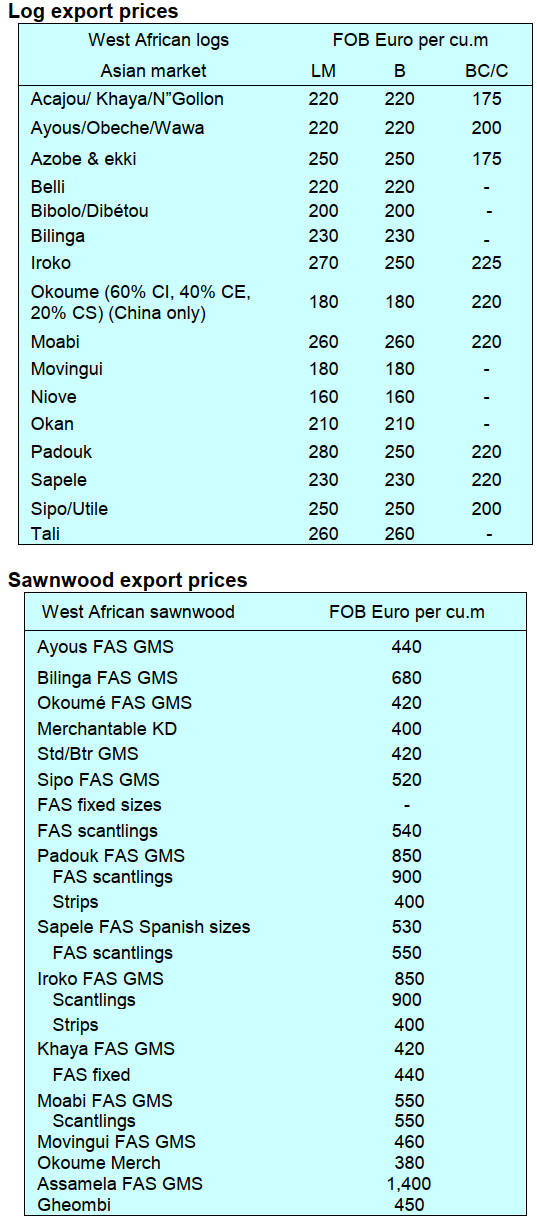
2.
GHANA
IMF disbursement after fourth review
On 7 July 2025 the International Monetary Fund (IMF)
Executive Board concluded its fourth review of Ghana’s
ongoing 18th IMF programme which began in May 2023.
Completion of the review unlocked a new disbursement of
US$370 million bringing the total support under the
programme to US$2.3 billion. This is a positive
development for the Ghanaian cedi.
The injection of the IMF funds into the economy will
boost foreign exchange reserves and support the local
currency. The IMF is, however, urging the Bank of Ghana
to reduce its interventions in the foreign exchange market.
The successful review of the Extended Credit Facility
(ECF) is seen as a positive indicator of progress of the
country’s macro-economic reforms and fiscal discipline.
See: https://www.imf.org/en/News/Articles/2025/07/07/pr-
25242-ghana-imf-completes-the-4th-review-under-the-ecf-
arrange
and
https://www.graphic.com.gh/business/business-news/imf-
executive-board-approves-370-million-disbursement-for-
ghana.html
Primary products account for 70% of wood exports
Wood products export for the period January to April 2025
totalled 77,492 cu.m valued at Eur36.48 million against
that recorded for the same period in 2024 which was
86,755 cu.m valued at Eur39.29 million according to data
source from the Timber Industry Development Division
(TIDD) of the Forestry Commission. These figures
registered decreases of 11% and 7% in volume and value
respectively year-on-year.
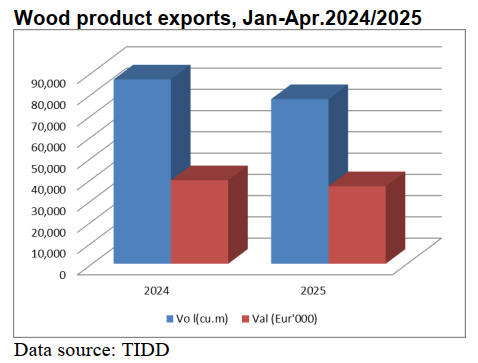
The country’s export statistics classified these products as
Primary, Secondary and Tertiary as shown in graph below.
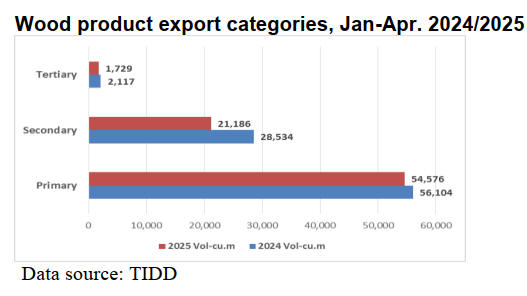
Primary products such as air-dried sawnwood, boules,
billets, teak logs, kindling, poles and rollboard accounted
for 70% (54,576 cu.m) of the total export volume in the
first four months of 2025 (77,492 cu.m).
For the same period in 2024 these products accounted for
65% (56,104 cu.m) of the total export volume (86,755
cu.m).
Secondary wood products comprising kiln-dried
sawnwood and boules, veneers, plywood and briquettes
accounted for 33% and 27% respectively of the total
export volumes in 2024 and 2025. The corresponding
revenue from the secondary wood product exports were
Eur15.17 million for 2024 and Eur13.79 million for 2025.
Tertiary Wood Products (TWPs) which were mainly
mouldings and dowels accounted for 2,117 cu.m in 2024
(1,729 cu.m in 2025). These products accounted for 2%
each of the total export volume for the respective years.
Ghana’s export of secondary and tertiary wood products
recorded gains in their average unit prices for 2025
compared to 2024. However, the AUP of primary product
dipped by 2.4%.
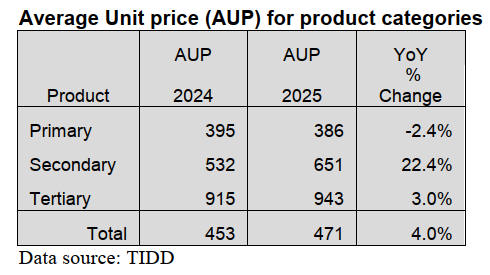
Tertiary wood products recorded the highest AUP of
Eur943/cu.m, followed by the secondary wood product at
Eur651/cu.m and primary products also at Eur386/cu.m
during the period January to April 2025.
The overall average unit price( AUP) saw a slight increase
of 4.0% from Eur453/cu.m in January-April 2024 to
Eur471/cu.m over the same period of 2025. The leading
export species during the period were teak, wawa, ceiba,
denya and cedrela.
Business and investor confidence improving
The Chief Executive Officer of the Association of Ghana
Industries (AGI), Seth Twum-Akwaboah, has stated that
business and investor confidence in Ghana has seen
significant improvement over the past six months.
Mr. Twum-Akwaboah attributed this improvement to
enhanced engagement between the public and private
sectors as well as favourable macroeconomic environment
in recent times which are beginning to yield positive
results and restoring optimism within the business
community.
The CEO added that while the signs are encouraging
there’s still work to be done. He therefore urged
policymakers to maintain the momentum by addressing
structural challenges such as high production costs, access
to credit and bureaucratic delays which continue to affect
many local businesses.
He also called for more directed policies to support
manufacturing, innovation and value addition to
strengthen Ghana’s industrial base, necessary if Ghana
seeks to accelerate economic growth and attract foreign
investment.
PriceWaterhouse Coopers (PwC) report on the 28th
Annual CEO Survey has indicated that 64% of CEOs in
Ghana are optimistic firms will thrive beyond the next
decade if they stick to their current business models or
plans. This percentage is considerably higher than their
peers in Africa (52%) and globally (55%) who share
similar convictions.
The Bank of Ghana’s May 2025 Summary of Economic
and Financial Data has also revealed that the country’s
Business Confidence Index increased to 102.2% in April
2025 when compared to 92.6% for the same period in
2024 and 90.9% in December 2023.
Meanwhile according to the Ghana Statistical Service
(GSS), Ghana’s year-on-year inflation rate for June 2025
fell to 13.7%.
See: https://www.myjoyonline.com/business-and-investor-
confidence-improving-agi/
and
https://www.myjoyonline.com/64-of-ceos-in-ghana-optimistic-
firms-will-thrive-beyond-next-decade-if-pwc-report/
and
https://www.pwc.com/gh/en/assets/pdf/ceo-survey-ghana-
2025.pdf
BoG policy rate likely to drop to 25%
According to IC Research Institute the Monetary Policy
Committee (MPC) of the Bank of Ghana may cut the
policy rate by 300 basis points to 25% which it attributed
to a sharp fall in inflation in June 2025 which was 13.7%.
The MPC of the Bank of Ghana maintained the policy rate
at 28% in May 2025 citing the need to consolidate gains
made in controlling inflation and supporting currency
stability.
According to the Governor, Dr. Johnson Asiama, the
decision was driven by the central bank’s latest forecast
which indicated a continued easing of inflationary
pressures, supported by a tight monetary policy stance,
relative exchange rate stability and ongoing fiscal
consolidation.
See: https://www.myjoyonline.com/bog-to-cut-policy-rate-by-
300-basis-points-to-25-ic-research/
and
https://www.myjoyonline.com/ghanas-international-reserves-hit-
6-months-of-import-cover-mahama/
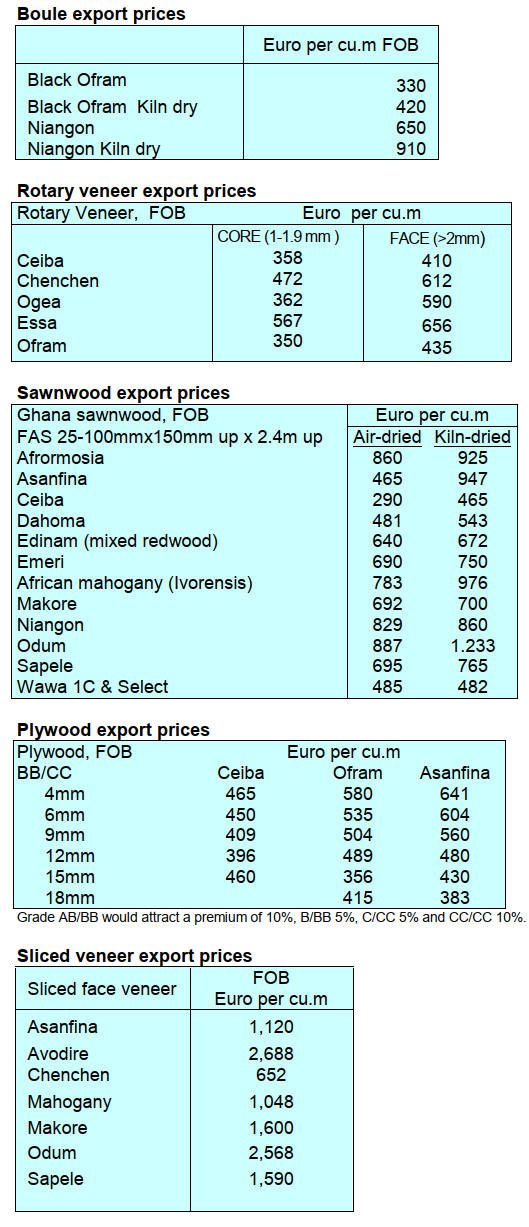
3. MALAYSIA
Looming demand shock from the US tariffs
Economists recommend Malaysia should urgently rethink
its strategy to secure a trade deal with the US to avoid a
long-term economic fallout. They warn of a looming
demand shock from the US tariffs and urge policymakers
to reassess their approach, including boosting imports
from the United States and addressing non-tariff barriers.
The US tariff on imports from Malaysia was increased to
25%, up from 24%, effective 1 August. This is more
favourable than tariffs for Thailand (36%) and Indonesia
(32%) but higher than that for Vietnam.
Sunway University economics professor and government
adviser, Yeah Kim Leng, said Malaysian exporters,
particularly in US-exposed sectors, could see reduced
orders as American buyers cut back purchases. “The key
question now is whether market share will shift due to
relative price changes stemming from the varying tariff
levels with countries with lower tariffs potentially gaining
a competitive edge” said Yeah.
Malaysian Furniture Council president, Desmond Tan,
said Vietnam, Malaysia’s closest competitor in the global
furniture market, produces a similar range of products and
targets the same export destinations, especially the US.
Tan said the industry is also being squeezed by rising costs
on the domestic front. “These include the expanded Sales
and Service Tax (SST), which now imposes a 5% tax on
raw materials and directly drives up production costs. We
also face higher labour expenses with the new minimum
wage” he added.
See: https://www.thestar.com.my/business/business-
news/2025/07/09/tariff-strategy-shift-crucial#goog_rewarded
and
https://www.thestar.com.my/news/nation/2025/07/10/govt-
urged-to-intervene-as-new-us-tariff-brings-jitters-for-businesses
Green furniture certification
The Forest Research Institute Malaysia (FRIM) is guiding
furniture makers to obtain Green Furniture Certification,
aiming to give them a competitive edge in the global
market that increasingly favours sustainable and eco-
friendly products.
Green Furniture refers to pieces crafted from sustainable
materials through environmentally responsible, recyclable
processes with minimal impact on nature. The certification
assures consumers of quality and safety and would
position Malaysian furniture alongside international eco-
friendly products.
By offering designs that are both appealing and ‘healthy’
for people and the environment, Malaysian furniture
producers stand to compete effectively in the global
market, a representative from FRIM said.
He noted that green certification aligns with national goals
to promote a green economy and support the United
Nations Sustainable Development Goals (SDGs).
He said Malaysia’s rich natural resources such as timber,
bamboo, rattan and other natural fibres present significant
potential for the green furniture sector. The first stage of
the FRIM Green Furniture certification process covers raw
material verification and safety testing while the second
stage adds performance evaluations for health and safety
standards.
See:
http://theborneopost.pressreader.com/article/282235196673084
Sabah’s net carbon sink a valuable asset
Sabah's status as a net carbon sink is a rare and valuable
asset that must be protected, said State Assistant Minister,
Abidin Madingkir. "Put simply, we absorb more carbon
than we emit. We are among the few jurisdictions in the
world with this status," he said when tabling the Sabah
Climate and Carbon Governance Enactment 2025 in the
State Assembly.
Abidin said Sabah accounted for about 36% of Malaysia's
total carbon sequestration giving it a strategic edge in a
carbon-constrained global economy. Sabah completed its
first comprehensive Greenhouse Gas Inventory in 2024
and is already aligned with Malaysia's 2050 net zero target
under the Paris Agreement.
The bill was passed and includes establishment of a Sabah
Climate Change Action Council, a Climate Registry,
Inventory Centre and the Sabah Climate Fund.
See:
https://www.nst.com.my/news/nation/2025/07/1241899/sabah-
tables-climate-bill-protect-carbon-sink-status
FRIM support for reforestation efforts in Saudi Arabia
Forest Research Institute Malaysia Incorporated (FRIM
Inc.) has signed a memorandum of understanding with
DMELL Global to supply tree planting material in support
of Saudi Arabia’s green initiative. The partnership is
meant to supply high-quality forest tree planting material
to bolster large scale reforestation efforts in Saudi Arabia.
Under the agreement, FRIM Inc. would supply up to eight
million trees annually.
FRIM sees this as the foundation for a broader partnership,
including technical consultancy, knowledge sharing,
capacity building and joint environmental planning.
Beyond providing planting materials, FRIM is equipped to
deliver end-to-end support, from technical consultancy to
on-the ground location guidance.
See:
http://theborneopost.pressreader.com/article/281968908691739
4.
INDONESIA
Export Benchmark Price (HPE) April 2025
The following is the list of Wood HPE from 1 July to 31
July, 2025.
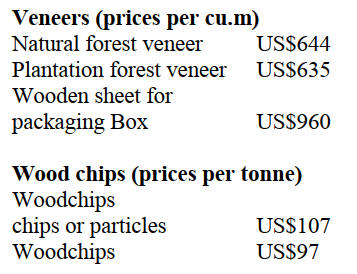
Processed wood (prices per cu.m)
Processed wood products which are leveled on all four
sides so that the surface becomes even and smooth with
the provisions of a cross-sectional area of 1,000 sq.mm to
4,000 sq.mm (ex 4407.11.00 to ex 4407.99.90)
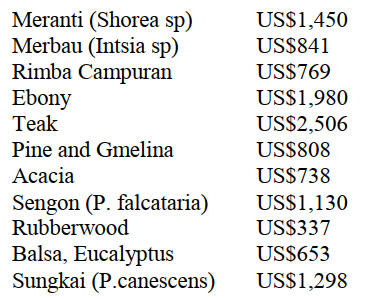
Processed wood products which are levelled on all four
sides so that the surface becomes even and smooth of
Merbau wood with the provisions of a cross-sectional area
of 4000 sq. mm to 10,000 sq.mm (ex 4407.11.00 to ex
4407.99.90) = US$1,500/cu.m
See: https://jdih.kemendag.go.id/peraturan/keputusan-menteri-
perdagangan-republik-indonesia-nomor-1552-tahun-2025-
tentang-harga-patokan-ekspor-dan-harga-referensi-atas-produk-
pertanian-dan-kehutanan-yang-dikenakan-bea-keluar
Import rules for forest products relaxed
The Indonesian government is highlighting the benefits of
its new import deregulation policy particularly for forest
products. On 2 July 2025 the Minister of Forestry, Raja
Juli Antoni, stated that this policy aims to provide legal
certainty, facilitate investment and create jobs.
The policy, a collaborative effort between the Forestry,
Trade and Finance Ministries, is the first phase of
Indonesia's strategy to boost global competitiveness. It
relaxes import rules for 10 commodities with forest
products being the largest group, encompassing 441 HS
code forest products.
The Minister of Trade, Budi Santoso, emphasised that
most imported forest products such as logs, plywood and
wooden crates serve as raw materials for industry making
this deregulation crucial.
While imported forest products no longer require Import
Approval (PI) from the Ministry of Forestry importers still
need to submit an import declaration.
The Minister of Trade, Budi Santoso, explained that the
deregulation was necessary to support industrial demand
while reducing pressure on domestic forests. By lifting
restrictions and prohibitions the government aims to
facilitate imports of raw materials while ensuring that
legal traceability of the wood is maintained through
declarations verified by the Ministry of Forestry.
See: https://en.antaranews.com/news/363405/ri-govt-highlights-
benefits-of-import-deregulation
and
https://finance.detik.com/berita-ekonomi-bisnis/d-
7988601/mendag-ungkap-alasan-longgarkan-impor-441-
produk-kehutanan.
SVLK relaxation not under review
The deregulation of forest product imports has sparked
renewed discussion about relaxing the Timber Legality
and Sustainability Assurance Program (SVLK) for
exports. However, the Minister of Trade clarified on 30
June that the SVLK, which pertains to exports, is distinct
from the recently announced import deregulation and is
not currently under review. He also confirmed there has
been no harmonisation between the two policies.
The Indonesian Furniture and Craft Industry Association
(HIMKI) has actively advocated for SVLK review
especially for small, labour intensive businesses in the
downstream sector. HIMKI asserts that the industry
supports the local economy and does not contribute to
deforestation. With furniture exports valued at US$2.5
billion in 2024, HIMKI aims to reach US$5 billion.
See: https://www.cnbcindonesia.com/news/20250630163310-4-
645007/sempat-muncul-wacana-relaksasi-svlk-ekspor-produk-
kayu-ini-updatenya
Government urged to secure preferential tariffs for
exports to the US
The Indonesian Furniture and Craft Industry Association
(HIMKI) called for strategic collaboration with the
Indonesian government to advocate for preferential tariffs
on furniture and craft exports to the United States.
HIMKI Chairman, Abdul Sobur, highlighted the urgent
need for a review of tariffs. He stressed that favorable
tariff policies could attract global investment, create
millions of jobs and significantly boost Indonesia's
furniture and craft exports.
To support the government's efforts HIMKI proposed five
key initiatives: Export Tariff Diplomacy, Market
Diversification, Export Ecosystem Reform, Fiscal
Incentives for Exporters and Domestic Market Protection.
These proposals aim to improve trade relations, simplify
export processes and safeguard the domestic industry.
Sobur reiterated that tariff policies are not merely financial
figures but impact the livelihoods of millions and the
future of Indonesia's strategic industries.
See: https://www.msn.com/id-id/berita/other/himki-dorong-
pemerintah-perjuangkan-tarif-preferensial-ekspor-mebel-
kerajinan-ke-as/ar-AA1HJdkS?ocid=BingNewsVerp
and
https://www.tribunnews.com/bisnis/2025/06/30/himki-dukung-
pemerintah-perjuangkan-tarif-preferensial-ekspor-mebel-dan-
kerajinan-ke-as
Concerns raised on impact of EUDR on smallholders
Indonesia is currently waiting for a formal response from
the European Union (EU) regarding its concerns over
the EUDR. Dida Gardera from Indonesia’s Coordinating
Ministry for Economic Affairs confirmed that Indonesia
submitted written questions to the EU after a bilateral
dialogue in Brussels on 4 June.
Key areas of concern include the legal basis and
methodology for the EUDR's risk classification,
the recognition of Indonesia's national legality system and
potential conflicts with World Trade Organization (WTO)
rules.
Indonesia has also highlighted the
significant administrative burdens the regulation could
place on smallholders particularly concerning digital
traceability and geolocation requirements.
Gardera stressed that over 90% of Indonesia's coffee and
cocoa producers are smallholders. He is reported as saying
the EUDR's demand for separating production from forests
might be incompatible with Indonesia’s sustainable
agroforestry practices, especially in coffee and cocoa
cultivation. Gardera cited examples, such as Perhutani's
coffee plantations in Java which apply sustainable
agroforestry that does not harm forest ecosystems, arguing
that a blanket application of the EUDR might not be
feasible for all crops.
See: https://en.antaranews.com/news/363805/indonesia-awaits-
eu-reply-on-deforestation-rule-concerns
Updating the nation's forestry regulations
On 29 June 2025 Indonesia's Parliamentary Commission
IV initiated discussions to update the nation's forestry
regulations as the current Law, No. 41 of 1999, is
considered insufficient for modern forest management
challenges.
During a Public Hearing on 25 June lawmakers, experts
and academics highlighted how overlapping provisions
with other sectoral policies, particularly involving
the Ministry of Agrarian Affairs and Spatial
Planning/National Land Agency (BPN) complicate
effective governance.
Sturman Panjaitan, a Commission IV member, emphasised
that the existing law, stemming from the reform era no
longer meets contemporary needs due to conflicting
regulations that could hinder sustainable forest
management.
He argued that a new legal framework is vital to provide
clarity, boost forest utilisation and ensure long-term
benefits for the population. Fellow Commission IV
member, I Nyoman Adi Wiryatama, agreed advocating for
a complete overhaul rather than mere revision.
Parliament is now gathering input from various
stakeholders, including civil society, forestry businesses
and indigenous communities. The goal is to draft a new
forestry law that better addresses Indonesia's current and
future ecological and economic challenges. This lengthy
process is deemed crucial for creating a more responsive
and effective regulatory system for forest management.
See: https://forestinsights.id/uu-kehutanan-dinilai-tidak-lagi-
relevan-dpr-ri-dorong-penyusunan-regulasi-baru/
In related news, Difa Shafira, from the Indonesian Centre
for Environmental Law (ICEL), stated that the current
classification of forests under Indonesia's Forestry Law
No. 41 of 1999 into conservation, protection and
production zones is outdated and ineffective.
She argues this system undermines forests' role as life-
support systems and fails to align with national emission
reduction targets in the Forestry and Other Land Use
(FOLU) sector. Beyond reform Shafira called for clearer
and more inclusive zoning criteria that considers the
ecological, cultural and social contexts of each region.
She emphasised integrating the needs of local
communities, indigenous peoples and regional
governments into forest management policies.
Environmental resilience and the land's capacity to support
human activity without degradation must be central to
zoning decisions. Shafira warned against generalising
forest management across Indonesia's diverse islands
urging more attention to the unique and fragile ecosystems
of smaller islands often overlooked in national policy.
See:
https://lestari.kompas.com/read/2025/06/26/211645686/pembagi
an-fungsi-hutan-dalam-revisi-uu-kehutanan-dinilai-sudah-tak-
relevan.
and
https://www.tempo.co/lingkungan/-pengaturan-hutan-adat-
dalam-ruu-kehutanan-1925180
Indonesia and UK strategic partnership set to be
concluded in September
Indonesia and the United Kingdom are set to finalise a
new strategic partnership agreement in September
according to the British Ambassador, Dominic Jermey.
This partnership aims to strengthen ties between the two
nations amidst global geopolitical shifts, emphasising
shared democracy and human rights issues.
The agreement will focus on human resource
development (especially in education and health),
economic growth, sustainable development (including
green energy and forest conservation). It is planned the
partnership will be formally launched during a meeting
between Indonesian President, Prabowo Subianto and UK
Prime Minister Keir Starmer.
See: https://en.antaranews.com/news/362029/new-indonesia-uk-
strategic-partnership-agreement-coming-september-2025
Indonesia’s planned trade pact with US partners
upended
Indonesia was set to sign a US$34 billion pact with
American business partners ahead of the 9 July US tariff
deadline. This aimed to boost imports from the United
States and was part of Jakarta's strategy to avoid the
threatened 32% tariff on Indonesian exports to the U.S.
But this initiative was overtaken by decisions from the US
government. The Indonesia government expressed surprise
and disappointment after learning the 32% tariff on
Indonesian exports to the US will stand.
The government had proposed significant measures to
address the US trade deficit including a pledge to increase
imports from the US by US$34 billion across sectors like
agriculture, energy and aviation.
The US decision contrasts sharply with plans to lower
tariffs on Vietnam (from 46% to 20%) and Cambodia
(from 49% to 36%). Indonesia now remains burdened by
both the 32% tariff hike and a 10% global baseline tariff.
Former WTO Ambassador, Iman Pambagyo, criticised the
US approach suggesting Indonesia should focus
on building resilience rather than trying to further appease
Washington.
Lili Yan Ing, Secretary General of the International
Economic Association, advised that ASEAN nations,
including Indonesia, should bypass direct engagement
with the US government and instead leverage the
influence of US corporations with strong interests in the
region to safeguard their interests. The 32% tariff is set to
take effect on 1 August 2025.
See: https://jakartaglobe.id/business/indonesia-offers-34-billion-
in-us-imports-to-secure-tariff-relief
and
https://jakartaglobe.id/business/indonesia-stunned-by-us-tariff-
decision-despite-34b-trade-offer
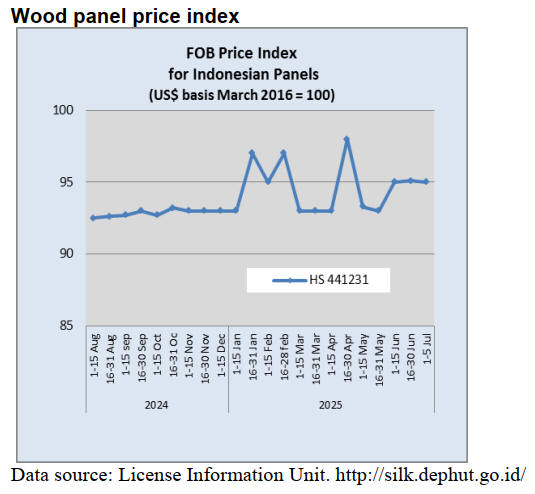
5.
MYANMAR
Myanmar dismisses World Bank economic forecast
Myanmar Prime Minister, Min Aung Hlaing, has publicly
challenged the World Bank's recent forecast of a
significant economic contraction for the country,
dismissing the forecast as based on "inaccurate and
incomplete data." His remarks were made during a
National Economic Development Coordination meeting,
as reported by state media.
The World Bank projected that Myanmar's economy
would shrink by 2.5% in the 2025/26 financial year. This
downturn was largely attributed to the devastating
magnitude 7.7 earthquake in March which inflicted an
estimated US$11 billion worth of damage, equivalent to
14% of Myanmar's GDP.
In contrast to the World Bank's assessment Min Aung
Hlaing claimed Myanmar's GDP was US$76.4 billion in
2024-25 and has a target of US$81.6 billion for 2025-26,
representing a US$5.2 billion increase.
"Regardless of external forecasts if the people remain
committed and hardworking we can defy these
expectations and achieve real GDP growth," he stated.
On the ground, Myanmar faces a multifaceted crisis,
including ongoing civil war, natural disasters, inflation,
job scarcity, currency devaluation and severe power
outages with millions grappling with post-earthquake
challenges.
See https://www.irrawaddy.com/business/economy/myanmar-
regime-leader-rejects-world-bank-economic-forecast-as-
inaccurate.html
ILO - Unprecedented action against Myanmar
In a landmark decision the 113th International Labour
Conference (ILC) adopted, by consensus, the resolution
invoking Article 33 of the International Labour
Organization (ILO) Constitution concerning Myanmar.
Invoking ILO Article 33 of its Constitution against
Myanmar is the strongest measure available to the
organisation. This unprecedented step, only the third in the
ILO's century-long history (previously used for Myanmar
in 2000 and Belarus in 2023) underscores the perceived
severe and persistent violations of workers' and human
rights in the country since the February 2021.
Myanmar has rejected the resolution, labeling it
"politically motivated" and claiming it will have "no
effect" on the country's labour landscape. The
administration maintains it is working with the ILO.
US tariffs and existing ILO measures against Myanmar
have created a challenging economic environment for its
export sectors. Recent reports indicate that the US has
imposed a 40% tariff on goods from Myanmar, effective 1
August 2025. This is a substantial increase as US tariffs on
Myanmar garment imports averaged around 20%.
Myanmar's garment industry is a major employer,
providing livelihoods for nearly 800,000 workers and
generating around US$5 billion in exports annually.
See: https://www.ilo.org/sites/default/files/2025-06/ILC113-
Record-2A-%5BSECTOR-250602-001%5D-Web-EN.pdf
and
https://www.scoop.co.nz/stories/WO2506/S00169/ilo-member-
states-implement-resolution-on-myanmar-junta.htm
and
https://www.thestar.com.my/aseanplus/aseanplus-
news/2025/06/12/earthquake-worsens-myanmar039s-economic-
decline-world-bank-says
6.
INDIA
Wood panel index declined
after 3 monthly increases
The annual rate of inflation based on the all India
Wholesale Price Index (WPI) was 0.39% in May. The
positive rate of inflation in May was primarily due to
increased prices for manufactured food products,
electricity, other manufacturing, chemicals and chemical
products, manufacture of other transport equipment and
non-food articles.
The index for Manufacturing remained unchanged at
144.9 in May 2025. Out of the 22 NIC two-digit groups
for manufactured products, 10 groups witnessed an
increase in prices, 9 groups witnessed a decrease in prices
and 3 groups saw no change in prices.
Some of the important groups that showed month on
month price increases were other manufacturing,
manufacture of other non-metallic mineral products,
computers, electronic and optical products,
pharmaceuticals, medicinal chemical and botanical
products and textiles.
Some of the groups that saw a decrease in prices were
manufacture of food products, basic metals; rubber and
plastics products, chemical and chemical products and
electrical equipment.
The price index for wood panels declined in May
after 3
months of increase. The sawnwood price index was little
changed from a month earlier but there was a decline in
the index for veneers.
See: https://eaindustry.nic.in/
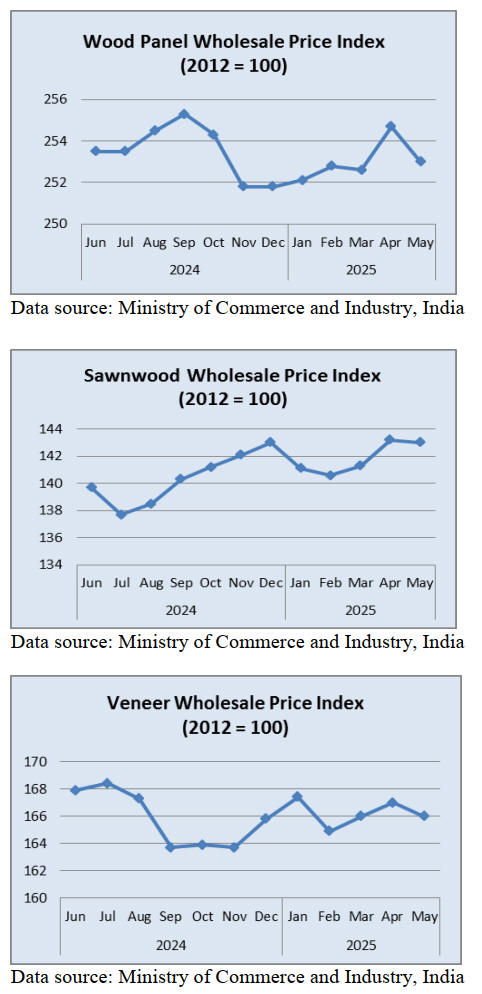
Veneer sector faces challenge in securing base ply
The correspondent wtites “Overall the markets are
improving. The decorative veneered plywood market is
facing lots of issues in India as factories and importers are
not able to import the base plywood for overlaying which
is the main raw material for manufacturing veneered
plywood/fancy plywood.
Earlier the BIS (Bureau of Indian Standards) office had
said that plywood less than 4 mm will be permitted as raw
material for fancy plywood manufacturers but the new
regulation which came in May has also restricted these
imports. So far the BIS has not granted any licence for
Plywood/MDF/Particle Board manufacturers in Vietnam,
Indonesia, China and Russia.
Ocean freight charges ares high but stable. The good news
is that the monsoon is progressing satisfactorily and
forecasts of India's growth have been positive”.
National Bamboo Mission (NBM) 2025
In a major effort for India’s bamboo industry the central
government launched a National Bamboo Mission (NBM)
2025 aimed at expanding bamboo cultivation,
strengthening industry linkages and reducing import
dependence.
The initiative focuses on increasing bamboo plantations on
non-forest lands, including farms, homesteads, community
lands and along irrigation canals. By raising farm incomes,
promoting climate resilience and ensuring a resilience and
ensuring a steady supply of raw material for industries,
NBM seeks to establish bamboo as a key economic driver.
A major aspect of NBM 2025 is improving post-harvest
management by setting up primary processing units,
treatment and seasoning plants and market infrastructure
near production clusters. The mission also places strong
emphasis on research, product innovation and skill
development to align with market demands.
To ensure sustainability, farmers producer organisations
(FPOs), self-help groups and entrepreneurs will be
actively involved facilitating better access to financial and
market support.
Ashish Kaswa, a Nagpur-based entrepreneur and bamboo
industry expert, praised Maharashtra’s investment, calling
it a major step toward unlocking the sectors potential.
“Maharashtra is leading in private bamboo plantations and
with the right policies it can become a hub for bamboo-
based industries” he said.
See: https://timesofindia.indiatimes.com/city/nagpur/rs-4300-
crore-maha-plan-to-boost-bamboo-
sector/articleshow/119881552.cms
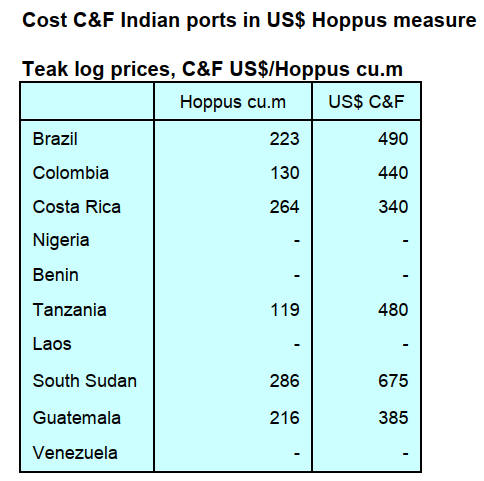
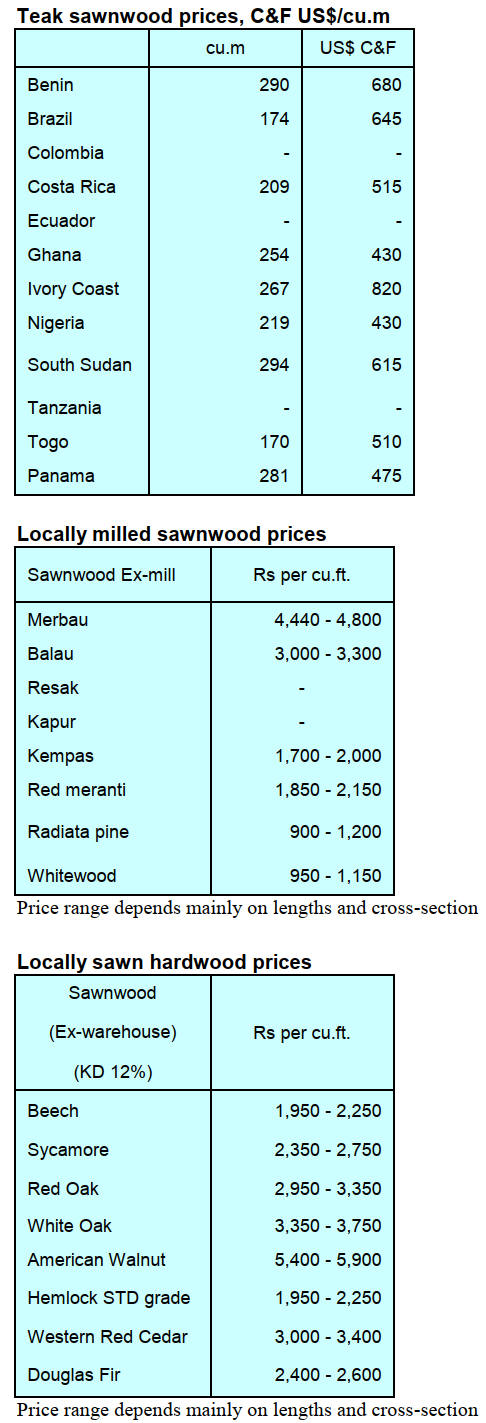
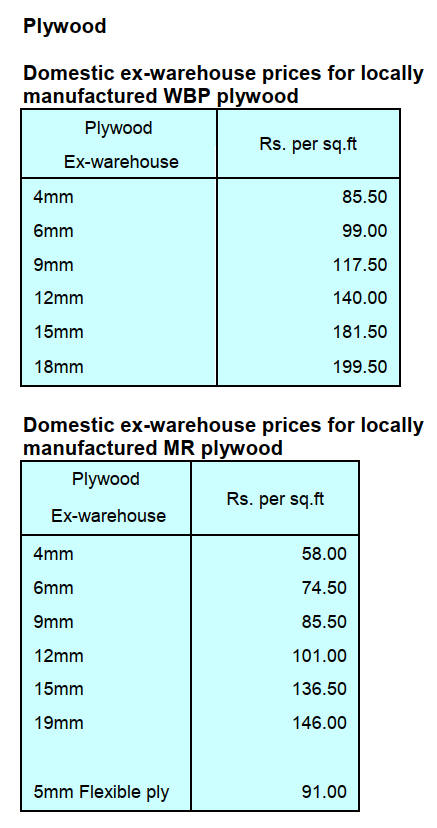
7.
VIETNAM
Wood and Wood Product (W&WP) trade
highlights
According to the Viet Nam Customs Department W&WP
According to Vietnam General Department of Customs
W&WP exports in June 2025 reached US$1.3 billion, an
increase of 4% compared to June 2024 of which, WP
exports contributed US$884 million, up 4% compared to
June 2024.
In the first six months of 2025 exports of wood and wood
products are estimated to have earned US$8.1 billion, an
increase of 8% compared to the same period in 2024 of
which WP exports accounted for US$5.55 billion, up 9%
compared to the same period in 2024.
Raw wood (log and sawnwood) imports in June 2025
reached 694,700 cu.m, valued at US$222.3 million, an
increase of 3% in volume and 5% in value compared to
May 2025. Compared to June 2024 there was an increase
of 51% in volume and 46% in value.
In the first six months of 2025 raw wood imports were
3.32 million cu.m valued at US$1.04 billion, an increase
of 34% in volume and 27% in value compared to the same
period in 2024.
NTFP exports in June 2025 reached US$75 million, down
6% compared to May 2025 bringing total exports of this
product group in the first half of 2025 to US$443.21
million, up 9% compared to the same period in 2024.
W&WP exports to the EU market in June 2025 amounted
to US$42 million, up 21% compared to June 2024. In the
first six months of 2025 exports to the EU earned about
US$302 million, up 9% compared to the same period in
2024.
Vietnam’s woodchip exports in June 2025 reached
US$170 million, down 6% compared to May 2025 and
down 13% compared to June 2024.
In the first half of 2025 woodchip exports were estimated
at US$1.19 billion, down 9% compared to the same period
in 2024.
Poplar wood imports into Vietnam in June 2025 totalled
26,600 cu.m valued at US$11.8 million, down 0.4% in
volume but up 0.3% in value compared to May 2025.
Compared to June 2024 imports were down 25% in
volume and 13% in value. In the first six months of 2025
imports of this item are estimated at 150,600 cu.m, valued
at US$64.0 million, down 15% in volume and 5% in value
compared to the same period in 2024.
Vietnam ‘low risk’ under EUDR
Vietnam has been classified as a “low-risk” country under
the EUDR. The classification means that Vietnamese
exports to the EU will be subject to simplified due
diligence requirements, easing the compliance burden on
businesses.
According to Tran Van Cong, Vietnam’s Agricultural
Counsellor to Belgium and the EC, the low-risk
classification is a positive outcome of sustained
cooperation between the two sides, including Vietnam’s
engagement in the Voluntary Partnership Agreement on
Forest Law Enforcement, Governance and Trade
(VPA/FLEGT) as well as efforts in environmental
protection and sustainable development.
See: https://bizhub.vietnamnews.vn/vn-classified-as-low-risk-
under-eu-anti-deforestation-regulation-post375983.html
Advancing legal framework for forest carbon market
The Government is in the process of finalising a draft
decree on forest carbon sequestration and storage services
which includes provisions on the transfer of forest carbon
credits.
Designed based on the principles of transparency,
accountability and balance of interests among the State,
forest owners and relevant stakeholders the draft, now
under public consultation, is expected to establish the
necessary legal foundation for the trading, payment and
management of forest carbon credits in both domestic and
international markets.
Key provisions in the draft Decree
Under the draft decree a forest carbon credit is defined as
the volume of CO₂ absorbed through sustainable forestry
practices which is measured, verified and certified by
domestic or international authorities and may be traded in
both national and global markets.
Notably, the draft decree clearly specifies parties to the
carbon market. Specifically, service providers include
forest owners; commune-level People’s Committees and
other organisations assigned forest management
responsibilities in accordance with law; foreign
organisations and individuals meeting certain conditions
(as specified in Decree 06/2022/ND-CP and Decree
119/2025/ND-CP) and domestic organisations and
individuals not regulated but wishing to use the results of
emission reductions or forest carbon credits to voluntarily
offset greenhouse gas emissions.
Under the draft, transactions would be conducted in two
forms: bilateral contract between relevant parties or via the
domestic carbon exchange. In either case, transactions
may only be conducted after the volume of emission
reductions and carbon credits has been verified and
approved by competent state authorities.
Payment methods include direct and indirect forms. In
direct payment, the service user pays the service provider
directly under a contract or according to the operational
mechanism of the domestic carbon exchange.
In indirect payment, the service user makes payment to the
service provider via entrustment through the Forest
Protection and Development Fund, based on a contract
with a state agency acting as the representative of the
service provider.
The draft decree also stipulates the payment rate. The
payment rate is the price for the exchange or transfer of
one ton of CO₂ or one forest carbon credit, calculated in
Vietnamese dong or another foreign currency.
Specifically, the determination of the price for the
exchange and transfer of forest carbon sequestration and
storage services with respect to forests under all-people
ownership would go through a three-step process:
First, the Ministry of Agriculture and Environment would
prescribe the method of pricing forest carbon sequestration
and storage services.
Second, provincial-level People’s Committees would,
based on the guidance of the Ministry of Agriculture and
Environment, issue a price list for forest carbon
sequestration and storage services applicable to forests
under local management.
Third, relevant parties would determine the starting price
or reserve price of forest carbon sequestration and storage
services on the domestic carbon exchange or in auctions
based on the price stated in the above-mentioned price list.
For the exchange or transfer of emission reductions or
carbon credits involving two or more provinces/cities, the
starting price/reserve price would be the highest among
the price lists issued by the relevant provincial-level
People’s Committees. In case neither the pricing method
nor the price list has been issued, the Ministry of
Agriculture and Environment will conduct negotiations
and report the case to the Prime Minister for the latter to
decide on a specific price.
The draft decree is expected to serve as a supplement to
Vietnam’s current legal framework governing the carbon
market.
On December 28, 2022, the Government promulgated
Decree 107/2022/ND-CP, on the pilot transfer of emission
reductions and financial management under the Emission
Reductions Payment Agreement (ERPA) for the North
Central region. The pilot program, which has been
implemented since the issuance of the Decree, will remain
in effect until the end of 2026.
Since the effective date of Decree 107, Vietnam has
successfully transferred over 10 million tonnes of CO₂ to
the World Bank’s Forest Carbon Partnership Facility at a
price of US$5 per tonne yielding over US$50 million.
Vietnam is the first among 15 ERPA signatory nations to
deliver all contracted carbon credits in the initial reporting
period.
See: https://vietnamlawmagazine.vn/vietnam-advances-legal-
framework-for-forest-carbon-market-74589.html
8. BRAZIL
Decree on forest replacement and
environmental
credits
The Government of Pará State has Published Decree No.
4.740/2025 which establishes a new regulatory framework
for forest replacement procedures and the granting of
forest compensation credits in the State. The goal is to
align with the current Brazilian Forest Code and replace
rules based on the former 1965 Forest Code.
The decree defines the technical, administrative and
operational criteria for obtaining, granting, transferring
and overseeing forest replacement credits. This measure
modernises the environmental compensation policy by
seeking to align rural production/farming with
environmental conservation, promoting sustainable
practices and the reforestation of native timber species.
The decree establishes that all individuals or legal entities
that use forest raw materials derived from the suppression
of native vegetation which, even if legally authorised,
should carry out forest replacement. This can be done
through four ways: direct planting with own resources;
participation in reforestation projects through associations
or cooperatives; Acquisition of existing credits or a
compensatory payment to the State Forest Development
Fund.
All operations involving the generation, transfer and use of
forest credits should be registered in the Pará State System
for Commercialisation and Transport of Forest Products
(Sisflora) and the Registry of Forest Product Exploiters
and Consumers (Ceprof).
The Pará Institute for Forest and Biodiversity
Development (Ideflor-Bio) and the State Secretariat for
Environment and Sustainability (Semas) are the agencies
responsible for monitoring and issuing certificates.
See: https://forestnews.com.br/para-regulamenta-por-decreto-
reposicao-florestal-e-concessao-de-creditos-ambientais/
Plan to boost investments in the Amazon
A plan to attract investments in the conservation,
restoration and sustainable development of the Amazon
was presented to the 30th United Nations Climate Change
Conference (COP30) presidency by seven civil society
organisations that have been active in the Amazon region
for over 30 years.
The plan entitled “Scaling Finance for Nature-Based
Solutions to Protect the Amazon: A Roadmap for Action”
not only proposes a framework to create climate finance
flows for the Amazon but also aims to consolidate actions
that enable the development of a green economy in the
region and strengthen the capacity to implement
sustainable initiatives in the biome.
According to Conservation International (CI), the plan
highlights that, although the Amazon generates around
US$317 billion annually, investments directed toward its
conservation totalled just US$5.81 billion between 2013
and 2022, a figure below the World Bank´s estimate of
US$7 billion per year needed to prevent the tipping point,
a scenario in which parts of the Amazon would turn into
savannah, altering rainfall patterns and causing
biodiversity loss.
CI points out that the World Bank data shows that only 3%
of these investments were allocated to nature-based
solutions for mitigating climate change and 11% were
used to adapt local infrastructure.
The roadmap proposes actions such as redirecting
subsidies from high-emission production chains to a green
economy, improving supply chain traceability through
satellite imagery and other technologies, payment for
environmental services and combating the illegal
economic activities in the region.
One of the main instruments to implement these actions is
the Tropical Forests Forever Fund (TFFF) which aims to
raise US$5 billion annually, with US$2 billion allocated
specifically to the Amazon, four times the average
investment made over the past decade.
The proposal also calls for drafting a Global Declaration
for the Amazon, encouraging countries under the Climate
Convention to commit to ensuring that the biome
continues to play a crucial role in addressing climate
change.
See: https://agenciabrasil.ebc.com.br/meio-
ambiente/noticia/2025-07/organizacoes-sociais-propoem-plano-
para-investimentos-na-amazonia
Exports
Furniture sector strategies to expand export markets
The furniture industry in Santa Catarina State is evaluating
strategies to mitigate impacts and address challenges
arising from the economic policies of the US, the main
external market for wooden furniture which accounted for
48% of State exports in 2024.
According to the Federation of Industries of Santa
Catarina State (FIESC), key concerns include a possible
tariff resulting from the US investigation into the impact
of wood and wood product imports on national security as
well as the risk of an economic slowdown in the US driven
by high inflation and persistently elevated interest rates.
Despite a heavy reliance on the US market, the sector
shows potential for diversifying its international markets.
FIESC’s analysis highlights a strong local production
chain in the furniture sector with 65% of inputs sourced
within the state and 43% of output directed to the domestic
market. The study also notes that R$100 million in orders
generate R$318 million in production value with the
potential to create approximately 2,800 jobs.
Despite the sector’s dynamism, attracting and training
skilled professionals remains a challenge. To strengthen
the sector’s image the furniture cluster in Planalto Norte
has launched AMPLIA, an initiative aimed at developing
strategies that promote the furniture industry’s recognition
and sustainable growth through professional skills
development, improved quality of life and technological
advancement in the region.
See: https://www.moveisdevalor.com.br/portal/setor-moveleiro-
debate-estrategias-para-ampliar-mercados-de-exportacao
EUDR drives traceability requirements for exports to
Europe
In 2023, the European Union (EU) established the
regulation on Deforestation-free products (EUDR), aiming
to combat global deforestation and the degradation of
forest ecosystems.
The EUDR mandates that companies exporting products
such as timber, cocoa, rubber, cattle, palm oil, coffee,
soybeansand their derivatives to the European market shall
demonstrate that their products do not originate from
deforested areas, ensuring traceability and transparency
throughout the entire supply chain.
In the forestry sector the regulation requires that, prior to
placing products on the EU market, exporters of timber
and forest products shall carry out due diligence to ensure
compliance with the regulation’s requirement.
To help meet the EUDR’s complex requirements a
Brazilian company has launched a digital platform to
support exporting companies in adapting to the regulation.
The platform also offers services such as geolocation,
legal assessments, preparation of the Due Diligence
Statement (DDS) and comprehensive support in regulatory
compliance management.
See: https://industriasa.com.br/uniao-europeia-exigira-
comprovacao-de-origem-sustentavel-em-produtos-
importados/?utm_campaign=marketingstcpcombr&utm_medium
=email&utm_source=RD+Station
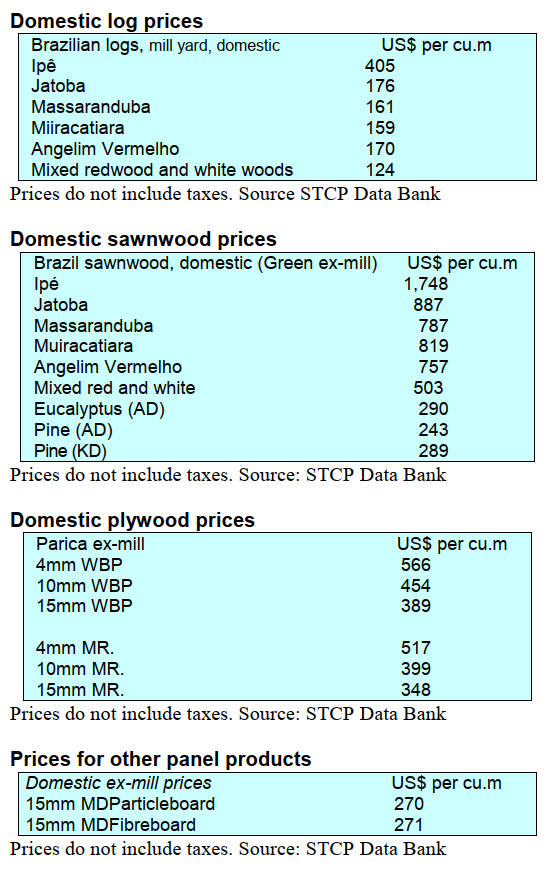
Export prices
Average FOB prices Belém/PA, Paranaguá/PR,
Navegantes/SC and Itajaí/SC Ports.
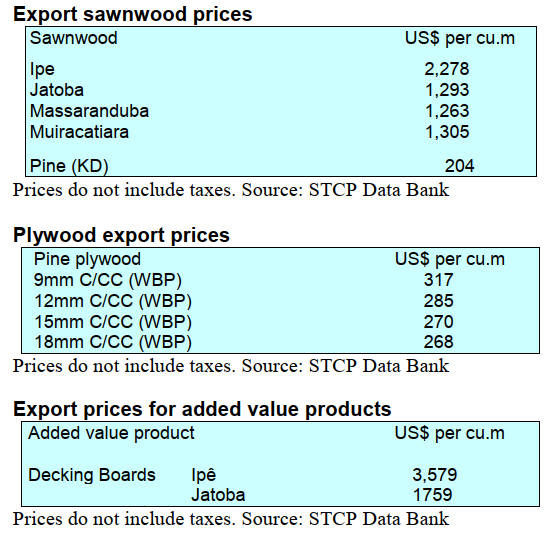
9. PERU
Veneer and plywood
export success
According to information provided by the Services and
Extractive Industries Department of the Association of
Exporters (ADEX), veneer and plywood shipments during
the January-April 2025 period reached an FOB export
value of US$914,000, growing by 148% compared to the
same period in 2024 (US$369,000).
The main export market for these products was Mexico
with a 52% share of exports and a positive increase year
on year of 64%, followed by Ecuador with a 29% share.
The Dominican Republic was in third place with an 8
share. Rounding out the top five were Colombia and Costa
Rica.
Forest regents strengthen technical role for
sustainable forest management
More than 50 forest regents gained experience in
technological tools used in forest oversight and in the
monitoring and follow-up procedures carried out by the
Forest and Wildlife Resources Oversight Agency
(OSINFOR). This was achieved through a workshop held
to ensure the efficient and sustainable management of
forest products in Peru, starting with the planning and
implementation of management plans.
Forest regents are professionals certified by the National
Forest and Wildlife Service (SERFOR) to provide
technical advice to forest users in the development and
implementation of management plans that ensure
responsible use of forest resources. Their work has a direct
impact on the results of the oversight carried out by
OSINFOR in the areas where the forest owners receive
their support.
During the event, the OSINFOR technical team explained
the use of satellite imagery and selective logging detection
algorithms as tools to strengthen the work of field
supervisors. They also discussed how the use of drones
(RPAs) has allowed for expanded monitoring coverage,
encompassing larger areas of forest.
See: https://www.gob.pe/institucion/osinfor/noticias/1203055-
regentes-forestales-fortalecen-su-rol-tecnico-para-una-gestion-
sostenible-del-bosque
Sawmillers participated in LIGNA 2025 Fair
A delegation of sawmill entrepreneurs from the Ucayali
and Madre de Dios regions participated in the 50th edition
of the LIGNA International Fair considered an important
global technology and innovation fair for the forestry and
wood products industry.
LIGNA proved to be a valuable platform for Amazonian
entrepreneurs who have been promoting modernisation
and value-added processes in their production lines. The
search for technologies to manufacture products such as
decking, deck tiles and finger jointing was one of the main
objectives of this participation.
During the Fair, the entrepreneurs not only established
direct contact with manufacturers of machinery and
cutting-edge technology but were also able to update their
knowledge, learn about new international market trends
and strengthen their networks with key players in the
sector.
In recent years demand for products made from tropical
wood such as decking, deck tiles and structural beams has
grown steadily in markets such as Europe and the United
States. This represents an opportunity for Peruvian
producers who need to invest in specialised machinery to
guarantee international standards of quality and
competitiveness such as those presented at LIGNA.
Participation in this Fair is part of the Amazonian private
sector's efforts to promote a sustainable, modern and
export-oriented timber industry.
Over one million hectares of FSC-certified forests
According to information provided by FSC Peru, the
country has 1,069,165.14 hectares of FSC-certified forests
of which 88 are private initiatives in the timber and paper
sectors.
The regions with the largest certified areas are: Madre de
Dios, with 578,793 hectares and a 54% share, followed by
Loreto with 358,186 hectares and a 34% share and finally
Ucayali with 132,186 hectares and a 12% share.
Peru assumes presidency of the Amazon Network of
Forest Authorities
After four days of dialogue among the forest authorities of
the eight countries in the Amazon basin Peru was elected
to preside over the Amazon Network of Forest Authorities
(RAFO) for the 2025-2027 term.
The country will host the Second Regional Meeting of this
Network which brings together the member countries of
the Amazon Cooperation Treaty Organization (ACTO).
Peru's election to the presidency of the forum constitutes a
significant milestone in forest governance in the Amazon
basin and reaffirms Peru’s commitment to a resilient,
sustainable, and humane Amazon.
The RAFO is comprised of forest authorities and
representatives from the Ministries of Foreign Affairs of
the eight ACTO member countries, Bolivia, Brazil,
Ecuador, Colombia, Guyana, Peru, Suriname and
Venezuela.
See: https://www.gob.pe/institucion/serfor/noticias/1207910-
midagri-peru-asume-la-presidencia-de-la-red-amazonica-de-
autoridades-forestales-rafo-2025-2027
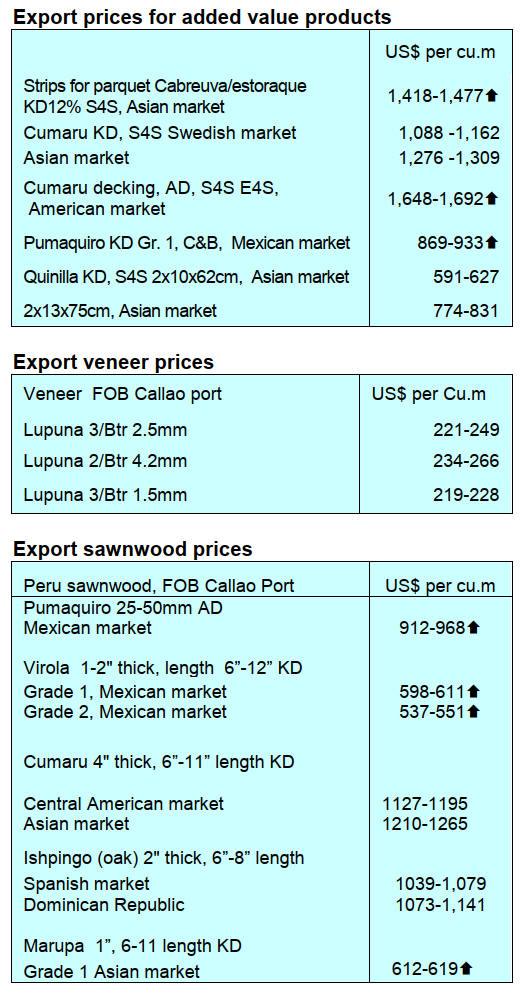 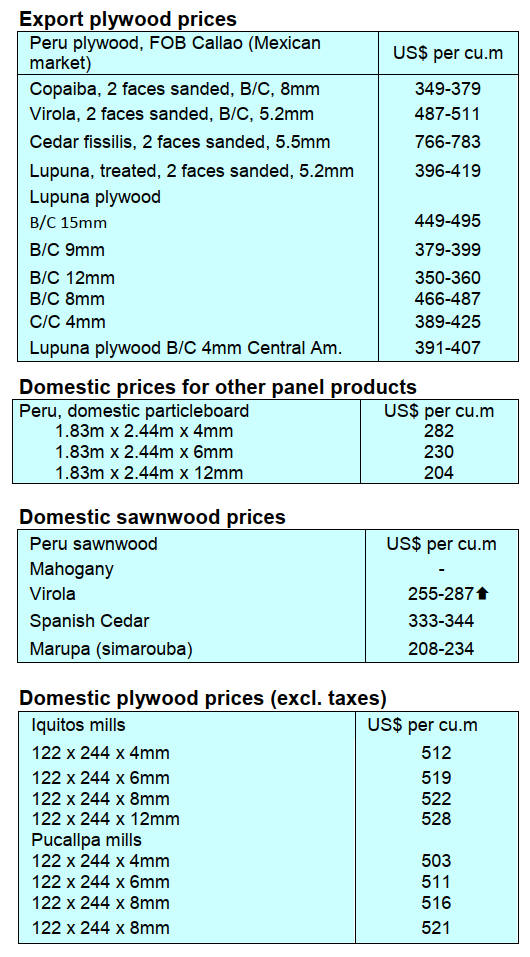
|